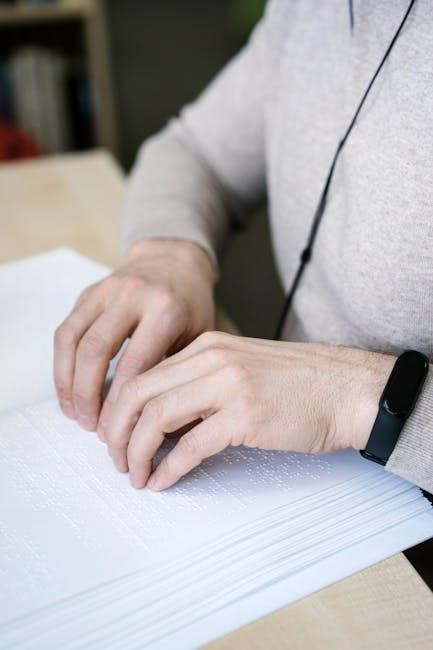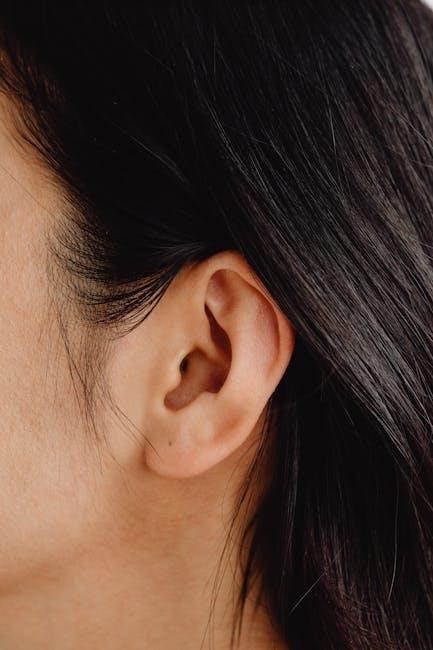nhs phonak hearing aid instructions

Phonak hearing aids, trusted for their advanced technology, are widely used in NHS programs. They offer comfort, clarity, and Bluetooth connectivity, making them ideal for various hearing needs.
1.1 Overview of Phonak Hearing Aids
Phonak hearing aids are renowned for their advanced technology and user-centric design, offering tailored solutions for diverse hearing needs. Known for their invisibility and comfort, models like the Phonak Lyric provide discreet, 24/7 wearability. The Phonak Slim, with its modern design, ensures a snug fit and ease of use. These devices integrate Bluetooth connectivity, enabling seamless pairing with smartphones and other devices. Phonak hearing aids are customizable, catering to different lifestyles and environments, whether in quiet settings or bustling spaces. Their rechargeable options and durable construction enhance convenience. The myPhonak app allows users to control settings, ensuring a personalized experience. Phonak’s commitment to innovation makes their hearing aids a popular choice for both NHS patients and private users, delivering clarity and confidence in everyday life.
1.2 NHS Hearing Aid Provision
The NHS provides Phonak hearing aids as part of its audiology services, ensuring access to high-quality devices for individuals with hearing loss. Eligibility is determined through audiological assessments, which evaluate the degree of hearing impairment. The NHS offers a range of Phonak models, including the discreet Lyric and the modern Slim design, tailored to meet diverse needs. These hearing aids are distributed through NHS audiology clinics, with professionals fitting and adjusting them to ensure optimal performance. The NHS also provides follow-up care, battery replacements, and maintenance support. This provision aims to enhance communication and quality of life for individuals, aligning with Phonak’s commitment to innovative and patient-centered solutions.

Eligibility Criteria for NHS Hearing Aids
Eligibility for NHS Phonak hearing aids is based on severe hearing loss, determined through audiological assessments. Criteria vary, but significant impairment typically qualifies individuals for NHS-provided devices.
2.1 Who Qualifies for NHS Hearing Aids?

Eligibility for NHS Phonak hearing aids is determined by the severity of hearing loss, assessed by audiology professionals. Typically, individuals with significant hearing impairment qualify. Children and adults with profound or severe hearing loss are prioritized. Eligibility criteria vary by region, but most NHS trusts require a referral from a GP or audiologist. Some areas may restrict access due to budget constraints, as seen in Devon, where only one hearing aid is provided. Patients with mild hearing loss may not qualify, and rationing measures, such as prioritizing one aid, are sometimes implemented. The assessment process ensures fair distribution based on clinical need and impact on daily life.
2.2 Assessment Process for Hearing Aids
The assessment process for NHS Phonak hearing aids begins with a referral from a GP or audiologist. An audiology team conducts a comprehensive hearing test, including pure-tone audiometry and speech recognition assessments. These tests evaluate the degree of hearing loss and its impact on communication. The results determine if hearing aids are necessary and, if so, which type suits the individual’s needs. The process also considers lifestyle, preferences, and the ability to manage the devices. If eligible, patients are fitted with Phonak hearing aids tailored to their specific requirements. The assessment ensures personalized care, optimizing hearing outcomes. This thorough evaluation aligns with NHS guidelines, ensuring equitable access to hearing solutions.

Key Features of Phonak Hearing Aids
Phonak hearing aids offer advanced sound clarity, Bluetooth connectivity, and a range of styles, including invisible options like Lyric, ensuring comfort and versatility for diverse hearing needs.
3.1 Phonak Lyric: Invisible Hearing Aid
The Phonak Lyric is a revolutionary, invisible hearing aid that sits deep within the ear canal, offering a natural listening experience. It is designed for individuals seeking a discreet solution without compromising on sound quality. Unlike traditional hearing aids, the Lyric is completely invisible when worn, making it an ideal choice for those concerned about the appearance of hearing aids. It provides clear sound in various environments and is suitable for individuals with mild to moderate hearing loss. The Lyric is also known for its ease of use, as it does not require daily insertion or removal, and it is powered by a small battery that lasts for an extended period. With the Lyric, users can enjoy a seamless and natural hearing experience without any visible device, making it a popular choice among many hearing aid users.
3.2 Phonak Slim: Modern Design and Comfort
Phonak Slim hearing aids are crafted with modern design and comfort in mind, tailored to suit the lifestyle of today’s users. Featuring a distinct left and right design, they incorporate a unique seven-degree angle for optimal fit and comfort. This ergonomic design ensures minimal visibility while providing excellent sound quality. The Slim model is lightweight and discreet, making it a popular choice for those prioritizing both style and functionality. With advanced noise reduction and clear sound capabilities, Phonak Slim hearing aids enhance listening experiences in various environments. Their sleek appearance and user-friendly features make them an excellent option for individuals seeking a balance between modern aesthetics and comfort.
3.3 Bluetooth Connectivity in Phonak Hearing Aids
Phonak hearing aids offer seamless Bluetooth connectivity, enabling users to connect to various devices like smartphones, tablets, and TVs. This feature allows for direct streaming of calls, music, and media, enhancing the listening experience. To pair the hearing aids, users can access the Bluetooth settings on their device, select the hearing aids, and confirm the connection. The myPhonak app further simplifies this process, offering personalized control over settings and connectivity options. Bluetooth connectivity ensures a convenient and wireless experience, making it easier to stay connected in everyday situations. This advanced feature is designed to provide clarity and comfort, catering to modern lifestyles and diverse hearing needs.
How to Obtain Phonak Hearing Aids Through the NHS
Obtaining Phonak hearing aids through the NHS involves a GP referral, audiological assessment, and fitting by an NHS audiologist, ensuring tailored solutions for hearing needs.
4.1 Referral Process from a GP
To obtain Phonak hearing aids through the NHS, patients typically start with a referral from their GP. During an initial consultation, the GP assesses symptoms and determines if a hearing aid is necessary. If appropriate, the GP issues a referral letter to the local NHS audiology department. Patients then contact the department to schedule an appointment. The referral process ensures that individuals receive a comprehensive audiological evaluation, leading to the fitting of suitable hearing aids, such as Phonak models, tailored to their specific needs.
4.2 Audiological Evaluation and Fitting
After referral, patients undergo a detailed audiological evaluation to assess their hearing loss and determine the most suitable Phonak hearing aids. This evaluation includes an audiogram and speech tests to measure hearing thresholds and understanding. Based on the results, an audiologist selects the appropriate Phonak model, such as the Lyric or Slim, ensuring a perfect fit and comfort. The fitting process involves programming the hearing aids to match the individual’s hearing profile. Patients are then shown how to use and care for their devices, including features like Bluetooth connectivity. Follow-up appointments are scheduled to monitor progress and make any necessary adjustments, ensuring optimal performance and satisfaction with the Phonak hearing aids.

Using Your Phonak Hearing Aids
Using Phonak hearing aids is straightforward. Turn them on, adjust volume manually, and pair with Bluetooth devices for seamless connectivity. They offer enhanced sound clarity and ease of use.
5.1 Turning the Hearing Aids On and Off
Turning your Phonak hearing aids on and off is a simple process. To activate them, use the rocker switch or button located on the device. You may hear a beep, indicating they are powered on. Some models also feature LED lights that flash or glow to confirm activation. To turn them off, press and hold the same switch until you hear a beep or the lights dim. Ensure the aids are fully powered down to conserve battery life. Always refer to your user guide for specific instructions, as some models may have unique features like automatic shut-off after a period of inactivity.
5.2 Adjusting Volume Manually
To manually adjust the volume on your Phonak hearing aids, use the rocker switch located on the device. Pressing the switch up increases the volume, while pressing it down decreases it. Some models may emit a beep or display an LED light to indicate volume changes. For precise control, adjust the volume in small increments and test the sound in your environment. If your hearing aids have a manual volume control, ensure it is set to your preferred level before turning them on. Always refer to your user guide for specific instructions, as some models may have additional features like volume limits or memory settings. Proper volume adjustment ensures optimal sound quality and comfort for the wearer.

5.3 Pairing Hearing Aids with Bluetooth Devices
To pair your Phonak hearing aids with Bluetooth devices, first ensure Bluetooth is enabled on your device. Turn your hearing aids off and then on again. After a few seconds, the hearing aids’ name will appear in the Bluetooth menu. Select it to pair. A beep or LED light will confirm the connection. For devices like phones or TVs, ensure they are in pairing mode. If using the myPhonak app, open it and follow the in-app pairing instructions. Some models may require a specific sequence to activate Bluetooth mode. Always refer to your user guide for model-specific instructions. Proper pairing ensures seamless connectivity and enhanced audio streaming directly to your hearing aids.
Maintenance and Care of Phonak Hearing Aids
Regular cleaning, proper storage, and battery care are essential for maintaining Phonak hearing aids. Use a soft cloth to wipe them and store in a dry place.
6.1 Cleaning the Hearing Aids
Cleaning your Phonak hearing aids regularly is crucial for optimal performance. Use a soft, dry cloth to gently wipe away dirt or moisture, paying attention to the microphone and speaker areas. Avoid using harsh chemicals, alcohol, or water, as these can damage the components. For stubborn debris, a small, soft-bristled brush can be used. Always handle the hearing aids with care to prevent scratches. Cleaning should be done daily to prevent wax buildup and ensure clear sound quality. Refer to your user guide for specific cleaning instructions tailored to your model. Regular maintenance will extend the life of your hearing aids and maintain their effectiveness.
6.2 Battery Care and Replacement

Proper battery care is essential to ensure your Phonak hearing aids function optimally. Always handle batteries with clean, dry hands to avoid moisture transfer. Use the correct battery size specified in your user guide. Avoid exposing batteries to extreme temperatures or humidity. When replacing batteries, open the battery door and gently remove the old ones, ensuring no debris remains. Insert the new batteries with the correct polarity, following the guide marks. Avoid mixing old and new batteries. If your hearing aids have rechargeable batteries, use the provided charger and avoid overcharging. Regularly check battery life and replace them when performance declines. Refer to your Phonak user guide for specific instructions on battery replacement and care.
6.3 Storing the Hearing Aids Properly
Storing your Phonak hearing aids correctly ensures longevity and optimal performance. When not in use, keep them in a cool, dry place away from direct sunlight and moisture. Use a protective case or storage box provided or recommended by Phonak. Avoid storing batteries in extreme temperatures or humidity. If the hearing aids are not used for an extended period, remove the batteries to prevent corrosion. Clean the devices before storage using a soft cloth or brush. Ensure the storage area is out of reach of children and pets. Regularly inspect the hearing aids for damage or debris before and after storage. Proper storage helps maintain functionality and prevents unnecessary repairs. Always refer to your Phonak user guide for specific storage recommendations tailored to your model.
Troubleshooting Common Issues
Troubleshooting common issues with Phonak hearing aids involves checking battery life, ensuring proper fit, and cleaning devices regularly. Use the myPhonak app for adjustments and refer to the user guide for detailed solutions.
7.1 No Sound or Weak Sound from Hearing Aids
If your Phonak hearing aids produce no sound or weak sound, ensure batteries are inserted correctly and not expired. Check for blockages in the earpiece or microphone, which may obstruct sound. Verify that the hearing aids are turned on and the volume is adequately adjusted. If using Bluetooth, confirm proper pairing and connection. Clean the devices regularly to remove debris. Consult the user guide for specific troubleshooting steps or contact NHS support for assistance. Persistent issues may require professional servicing or replacement.
7.2 Battery Life Issues
If your Phonak hearing aids experience short battery life, ensure batteries are stored properly and not exposed to extreme temperatures. Check the polarity to confirm correct installation. Avoid mixing old and new batteries, as this can reduce performance. If using rechargeable batteries, verify the charging dock is functioning correctly. Clean battery contacts regularly to maintain optimal conductivity. If issues persist, consult the user guide or contact NHS support for assistance. Battery life can vary depending on usage and environmental factors, so following proper care guidelines is essential to maximize performance and longevity.

Advanced Features of Phonak Hearing Aids
Phonak hearing aids offer advanced features like Bluetooth connectivity and the myPhonak app, enabling users to control settings and connect to devices. These innovations enhance hearing experiences seamlessly.
8.1 myPhonak App for Hearing Aid Control
The myPhonak app is a powerful tool designed to enhance the user experience of Phonak hearing aids. It allows individuals to control their hearing aids directly from their smartphone, adjusting settings like volume, treble, and bass. The app also enables users to customize their hearing aid settings for different environments, ensuring optimal sound quality in various situations. Additionally, the app provides real-time battery status updates and offers personalized recommendations to improve hearing comfort. With the myPhonak app, users can seamlessly connect their hearing aids to Bluetooth devices, stream audio, and manage their hearing aids with ease. This innovative solution empowers users to take full control of their hearing experience, making it more convenient and tailored to their needs.
8.2 Customizable Settings for Different Environments
Phonak hearing aids offer customizable settings tailored to various environments, ensuring optimal sound quality in diverse situations. Whether in noisy settings, quiet rooms, or outdoor spaces, users can adjust their hearing aids to suit their surroundings. The myPhonak app allows individuals to create and save personalized profiles, enhancing clarity and comfort. For instance, users can amplify speech in noisy environments or reduce background noise in quiet spaces. These settings can be adjusted manually or automatically, depending on the user’s preference. This adaptability ensures that Phonak hearing aids provide a seamless listening experience, catering to the unique needs of each wearer in any setting.

NHS Support and Aftercare
NHS provides comprehensive aftercare, including follow-up appointments, repairs, and troubleshooting. Users can access support for adjustments and maintenance, ensuring optimal hearing aid performance and user satisfaction.

9.1 Follow-Up Appointments
NHS offers regular follow-up appointments to ensure Phonak hearing aids function optimally; These sessions allow audiologists to fine-tune settings, address any issues, and provide personalized advice. Patients can discuss their experiences, ensuring their hearing aids meet their specific needs. Follow-ups are crucial for maintaining comfort and performance, especially during the initial adjustment period. They also offer opportunities for patients to learn more about their devices, such as how to clean and maintain them effectively. These appointments are typically scheduled at key milestones, like a few weeks after fitting, to monitor progress and make necessary adjustments for improved hearing outcomes.
9.2 Repair and Replacement Services
The NHS provides comprehensive repair and replacement services for Phonak hearing aids, ensuring continuous support for users. If damages occur, patients can return their devices for professional repair, often at no additional cost. Replacement services are also available if hearing aids are lost or beyond repair. These services aim to minimize disruption, ensuring users maintain their hearing capabilities. The process typically involves contacting the local audiology department, where staff assess the issue and provide timely solutions. This support system underscores the NHS’s commitment to delivering high-quality, sustainable hearing care to all patients, ensuring their Phonak hearing aids remain functional and effective for years to come.
Phonak hearing aids, supported by the NHS, offer advanced solutions for hearing loss. Their user-friendly designs and comprehensive aftercare ensure effective hearing improvement, empowering users to communicate confidently.
10.1 Summary of Key Points
Phonak hearing aids, provided through the NHS, combine advanced technology with user-friendly designs to address various hearing needs. The myPhonak app offers personalized control, while Bluetooth connectivity enhances convenience. Regular maintenance, including cleaning and battery care, ensures optimal performance. Troubleshooting tips, like checking for blockages or battery issues, help resolve common problems. NHS support includes follow-up appointments and repair services, ensuring long-term satisfaction. By balancing innovation and comfort, Phonak hearing aids empower users to communicate effectively in diverse environments. Proper usage and care, along with NHS aftercare, maximize the benefits of these devices, making them a reliable choice for individuals with hearing loss.
10.2 Final Tips for Using Phonak Hearing Aids
For optimal performance, regularly clean your Phonak hearing aids and store them properly when not in use. Ensure batteries are handled correctly and replaced as needed. Pairing with Bluetooth devices enhances connectivity, but remember to switch off unnecessary connections to conserve battery life. Adjust volumes manually or via the myPhonak app for personalized sound. Attend follow-up appointments with NHS audiologists to fine-tune settings and address any issues promptly. By following these tips, users can maximize their hearing experience and enjoy clear communication in various environments. Always refer to the user guide for model-specific instructions to get the most out of your Phonak hearing aids.
Leave a Reply
You must be logged in to post a comment.